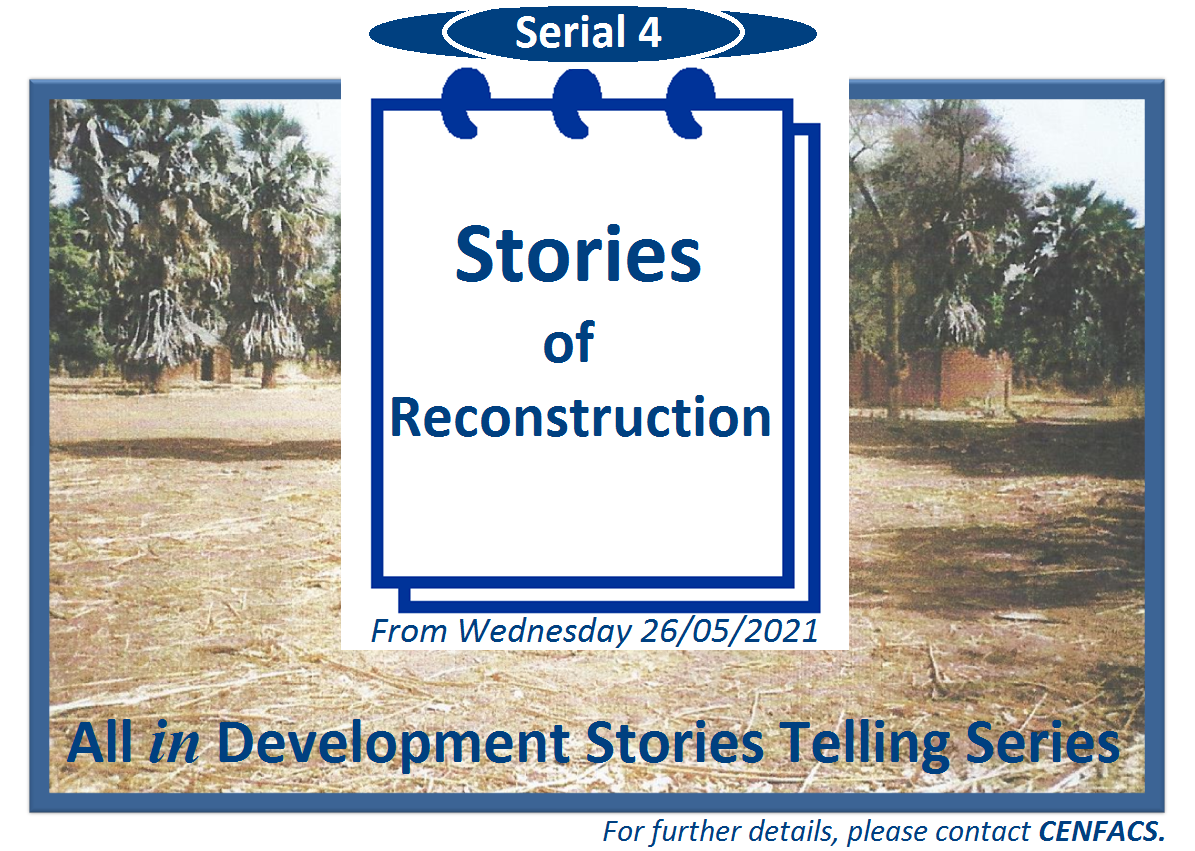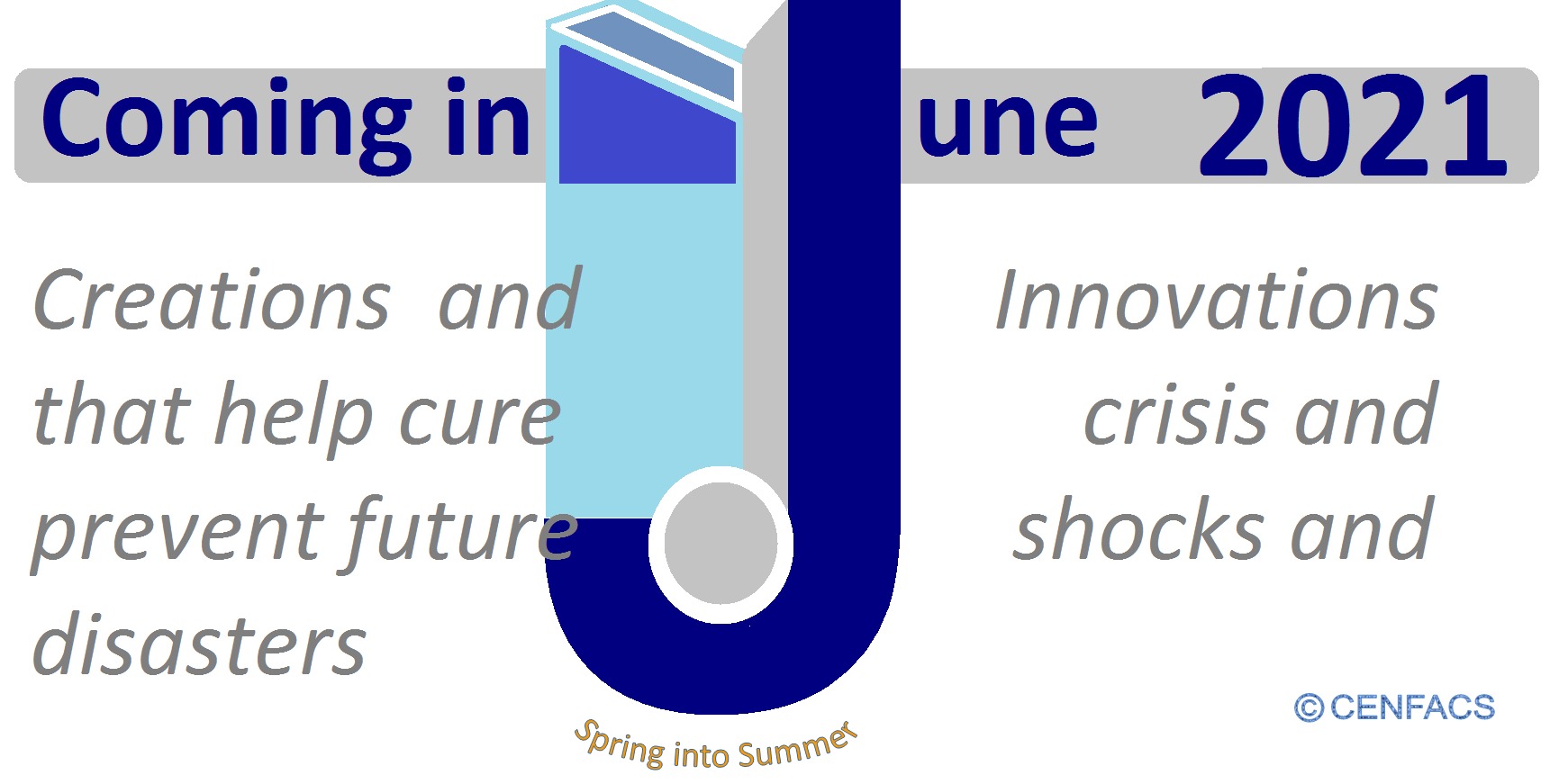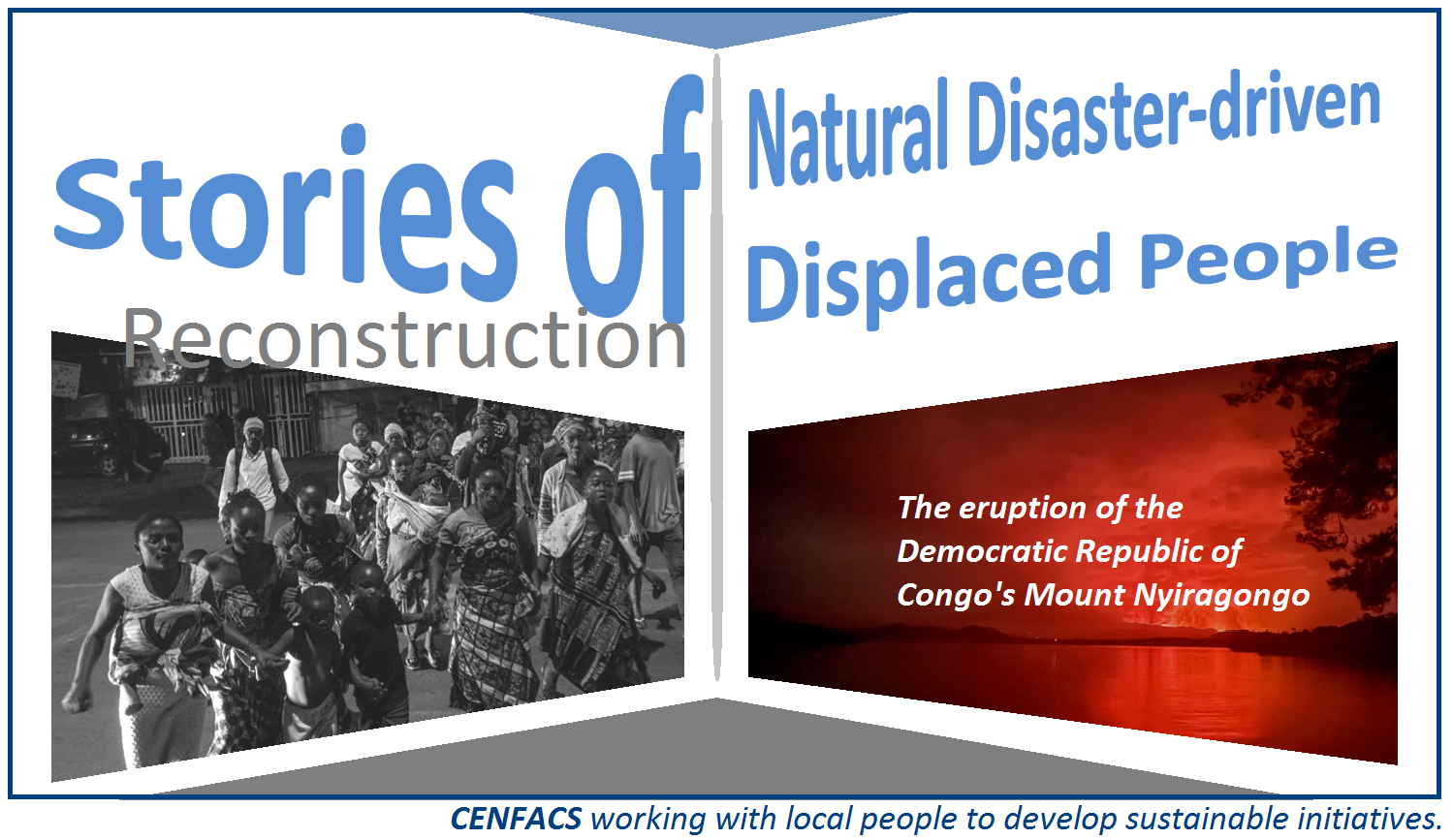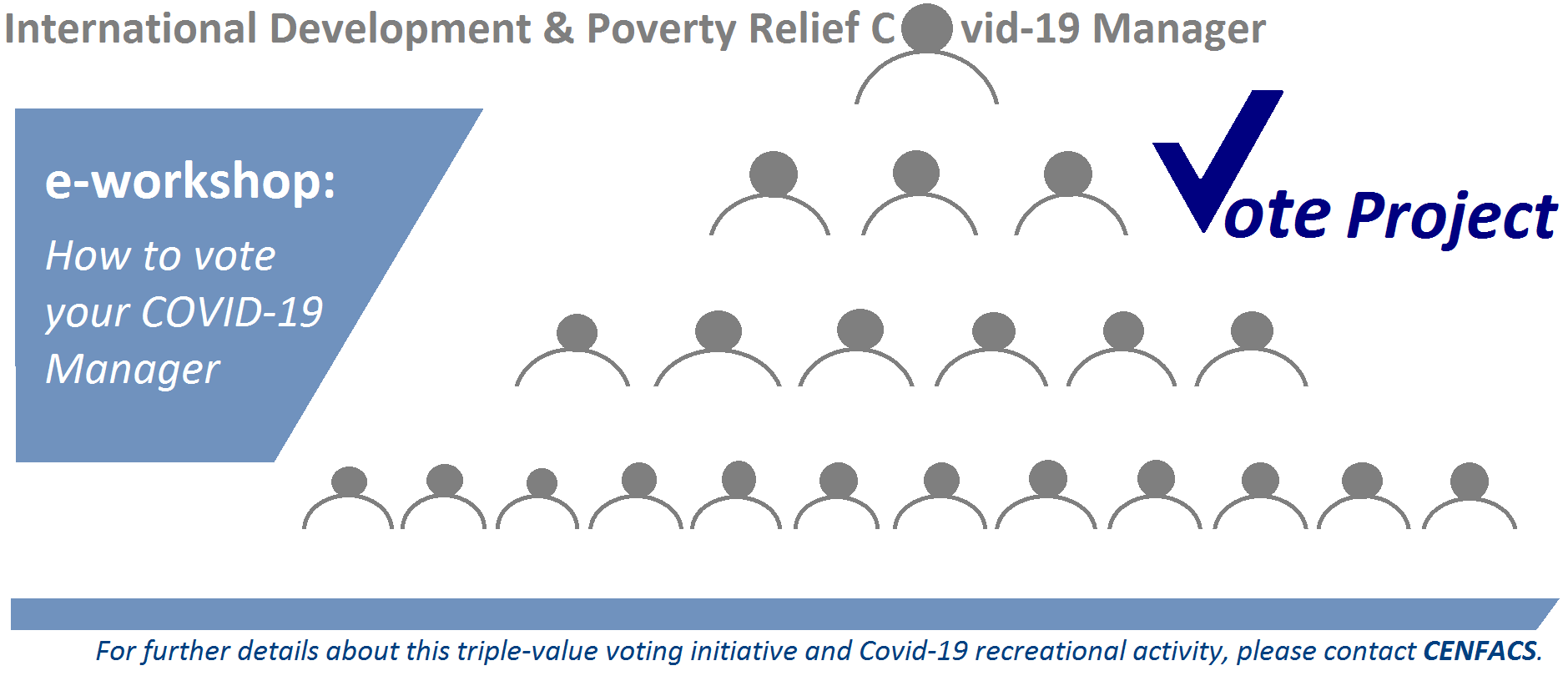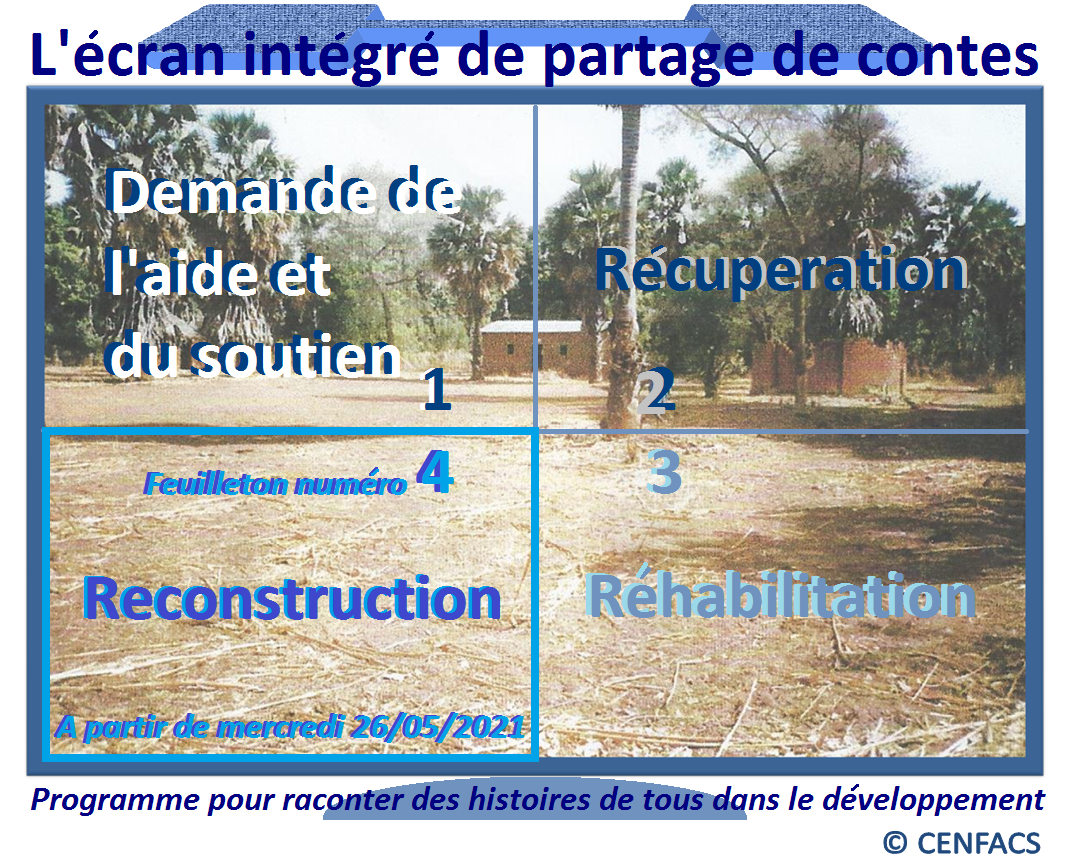Welcome to CENFACS’ Online Diary!
26 May 2021
Post No. 197
The Week’s Contents
• All in Development Stories Telling Serial 4 – In Focus from Wednesday 26/05/2021: Stories of Reconstruction
• Reconstruction Stories of Internally Displaced People and Returnees in Africa
• Stories of Volunteers’ Action across All Fronts of Build Back Better (i.e. Recovery, Rehabilitation and Reconstruction)
… And much more!
Key Messages
• All in Development Stories Telling Serial 4 – In Focus from Wednesday 26/05/2021: Stories of Reconstruction
The last episode of our series of AiDS (All in Development Stories) Telling and Sharing Programme is on Stories of Reconstruction. The latter are the serialised experiences or anecdotes of restoration to an original condition before the coronavirus crisis and containment measures.
The stories to be told, shared and learnt will be of rebuilding both people and communities in need after the coronavirus stroke and accidental damages caused by some of the measures meant to control the COVID-19 disaster. These serialised stories are part of the process of building back better greener and cleaner.
To join and / or steward the programme by telling and sharing your story, please contact CENFACS.
Under the Main Development section of this post, you will find notes highlighting this Serial 4.
• Reconstruction Stories from Internally Displaced People and Returnees in Africa
People continue to be involuntarily and internally displaced in many parts of the world including in Africa. They are displaced because of natural disaster-driven, conflict-fuelled and other factors.
For example, in their recent joint Global Report on Internal Displacement, the International Displacement Monitoring Centre and the Norway Refugee Council (1) have noticed the following:
6,780,000 (almost 27.4%) people were displaced by conflicts and violence, and 4,299,000 were displaced by disasters in 2020 in Sub-Saharan Africa. (p. 8)
Drawn-out conflicts and violence (in countries such as the Democratic Republic of Congo, Burkina Faso, Central African Republic, etc.) and natural disasters (like intense cyclones, torrential rains and floods) have involuntarily and internally displaced many people.
In the context of our AiDS Telling and Sharing Programme, one can tell and share stories of displaced persons returning to rebuild and reconstruct their damaged or destroyed homes and lives.
To tell and share your stories of the displaced and returnees who reconstructed their lives, please contact CENFACS.
• Stories of Volunteers’ Action across All Fronts of Build Back Better (i.e. Recovery, Rehabilitation and Reconstruction)
These stories could be related to actions generally taken in volunteering capacity to help people and communities in need to recover, rehabilitate and reconstruct from the coronavirus disaster and its side effects. They could also be actions in which a volunteer got specifically involved and at the fronts of recovery, rehabilitation and reconstruction processes.
To tell, share and provide opportunity for learning development through your story of volunteers’ actions across all the fronts of recovery, rehabilitation and reconstruction; please contact CENFACS.
Extra Messages
• E-workshop for Voters of International Poverty Reduction and Development Manager (IPRDM): Vote your IPRDM
How to choose your IPRDM
As part of CENFACS’ All Year Round Vote Project (that is, CENFACS International Poverty Reduction and Development Manager Project), we can work together to support you (as a voter) to choose or select the person you think that he/she would best help reduce poverty and enhance sustainable development in 2021.
There are reasons why we need to work together in choosing your IPRDM. The following can explain the need of working together:
<> Many people carry out work in the context and field of poverty reduction without sometimes realising that they are helping others to come out poverty and hardships
<> It could be sometimes difficult to identify, choose and nominate the one who really achieves tangible results in terms of helping others without gaining any personal benefit in exchange
<> It is even challenging to know who stands out the crowd.
Because of these reasons, it make sense to support each other in deciding who should be named the best International Poverty Reduction and Development Manager of 2021. He/she could be a COVID-19 Manager or a Disaster Risk Reduction Manager or a Post-disaster Reconstruction Programme Manager or anybody else.
To enable Voters of IPRDM to make data-based decision, we have put in place a decision-making process/model of working together to facilitate the selection or choice of Voters’ ideal IPRDM.
After following the e-workshop, one can master the skills that will enable them to find out an ideal International Poverty Reduction and Development Manager who is helping or who helped people and communities to both meet sustainable development goals and reduce poverty the era of Covid-19.
• • How to find out your IPRDM
To research your International Poverty Reduction and Development Manager (IPRDM), you need to take some steps before casting your vote. They include the following:
√ Write down your IPRDM job description
√ Write down your IPRDM person specification
√ Organise a timescale for each activity and set up a completion date
√ Watch or observe as many candidates as you can (watch work they are doing)
√ Check their CV, credentials and references
√ Assess their progress and achievements
√ Search your ideal three International Poverty Reduction and Development Managers within potential candidates you have been watching and match the best three candidates (after shortlisting) with job description, person specification, their achievements in terms of poverty reduction and sustainable development goals
√ Select one amongst the three who comes on top
√ Vote your IDPRM
• • Who is your IPRDM?
He/she is a person who would have met the defined person specification and job description in terms of helping those in most need and most vulnerable to achieve defined areas of sustainable development goals and reduce poverty in the era of Covid-19.
He/she is a person that can help poor people to meet their utility or welfare under the difficult context and constraint of Covid-19.
Please remember, whatever your ideal/virtual Manager is doing or will do, he/she needs to help people meet sustainable development and poverty reduction goals in the Age of COVID-19.
Good luck in search of your IPRDM!
For any enquiries or queries about this e-workshop, please do not hesitate to contact CENFACS.
• Convergence between Reduction of Energy Poverty and Zero Carbon Dioxide Emissions by 2050
In the light of the International Energy Agency’s (2) call for a ban on new coal, gas and oil projects to reach zero carbon dioxide emissions by 2050, CENFACS is revisiting its Goal 3 of tackling and reducing energy poverty.
The Goal of Reduction of Energy Poverty (or Goal 3) is the one CENFACS set in its 2020s Poverty Reduction Programme and Development Agenda. Energy poverty can be defined in many ways. According to Habitat for Humanity (3), energy poverty is
“A lack of adequate, affordable, reliable, quality, safe and environmentally sound energy services to support development”.
Energy poverty forms part of CENFACS’ 2020s Poverty Reduction Programme and Development Agenda. As part of these programme and agenda, it makes sense to reduce it since many people and communities in Africa are still struggling from energy access distribution. Without putting statistical data on this lack of access, there are still hugely considerable numbers of people in Africa without access to electricity.
For example, the COVID-19 crisis and vaccines have openly exposed the lack of capacity in terms of electricity and fridges to store vaccines in many parts of Africa.
In Africa, many people are still lacking access to clean cooking facilities while relying on polluting energy sources or fuels such as solid biomass, coal and kerosene to meet their basic life-sustaining energy needs. Yet, the achievement of universal energy access by 2030 is the United Nations Agenda (4) for Sustainable Development Goal 7 of ensuring access to affordable, reliable, sustainable and modern energy for all.
Energy transition is the 2020s challenges for Africa if people, especially the poor ones, are requested to find sustainable way of consuming energy while still keeping pace with poverty reduction and sustainable development.
One can hope in the process of building back better greener cleaner from the coronavirus, Africa will find its tune or way of making convergence between the goal of reduction of energy poverty and the goal of zero carbon dioxide emissions by 2050.
To discuss this convergence, please contact CENFACS.
• Stories of Those at Risk of Being Left behind Build Back Better from the Coronavirus Disaster and Containment Measures (i.e. social distancing, lockdowns and border closures)
The process of building back better may not do justice to everybody for various reasons which are sometimes difficult to identify.
There are people and / or members of our community who have been accidentally left behind in the process of building back better from the coronavirus disaster and containment measures.
We would like to hear the narratives of these people and community members so that advocacy can be activated and stepped up to do something about their situation.
Anyone has who has the stories of the left behind, they can join and steward the AiDS programme by telling and sharing them with us.
Main Development
• All in Development Stories Telling Serial 4 – In Focus from Wednesday 26/05/2021: Stories of Reconstruction
To develop the notes for this Serial 4, we have assembled the following pieces:
Understanding of reconstruction, reconstruction in the context of AiDS Telling Programme, reconstruction as part of the process of building back better, story scene settings, types of stories wanted, and social media as reconstruction story tracking tools.
• • Understanding of reconstruction
There are many ways in which reconstruction can be understood and defined. The definitions we have selected within the literature are as follows.
Jha et al (5) define reconstruction as:
“The restoration and improvement, where possible, of facilities, livelihoods and living conditions of disaster-affected communities, including efforts to reduce disaster risk factors. It is focused primarily on the construction or replacement of damaged physical structures and the restoration of local services and infrastructure”.
However, Thurairajah et al (6) contend that
“Reconstruction is a rebuilding measure which involves not only constructing physical structures but also building the confidence, self-respect, self-esteem, self-dependency, mutual support and mutual trust and, the rebuilding of communities. This long-term process focuses on human and material resource development, coordinated effort towards independence, sustainability, and empowerment” (p. 1106 & 1107)
In order to tell and share stories in this Serial 4, our understanding of reconstruction will revolve around both physical and non-physical structures. It will be in the context of building back better greener and cleaner.
• • Reconstruction as part of the process of building back better greener and cleaner
Reconstruction will be approached from the build back better perspective. From this perspective, the definition which is appropriate is the one given by the United Nations Assembly (7) arguing in 2016 that
“Reconstruction is the medium- and long-term rebuilding and sustainable restoration of resilient critical infrastructures, services, housing, facilities and livelihoods required for the full functioning of a community or a society affected by a disaster, aligning with the principles of sustainable development and build back better, to avoid or reduce future disaster risk”
From this definition, let us focus on alignment with the principles of sustainable development. One of these principles is to do with green and clean development.
From this principle, it would better for those submitting stories of reconstruction to make sure that their stories are of building back greener and cleaner. They are of environment-friendly (that is, they have a small or zero environmental impact) and reduce waste in the nature.
These could be the stories of lowering emissions of greenhouse gas, of reducing climate-damaging carbon dioxide emissions, of spearheading green energy solutions and increasing the share of renewables in the energy mix in the process of reconstructing lives.
• • Reconstruction in the context of AiDS Telling Programme
The definitions of reconstruction we are using are the ones we have given above. For those who would like to tell and share their stories, they can refer to the above definitions. For those who may have a different approach to reconstruction than the ones we have highlighted from the above definitions, they can still submit their stories while specifying the kinds of reconstruction they are using or have in mind.
• • Story scene settings
When we are talking about reconstruction, one may think about the American reconstruction after the civil war in the 18th Century or the European reconstruction after the World War II in the 19th Century or the Congolese reconstruction after the two waves of war in the Democratic Republic of Congo in the 1990s and early 2000s (i.e. 1996-1997, then 1998-2003) or any other reconstruction experience. However, the reconstruction we are referring to is the one after the COVID-19 outbreak. It is the reconstruction forming part of the building back better process from the coronavirus that broke out in 2019. So, stories to tell and share are those relating to the post-COVID-19 disaster reconstruction.
• • Types of stories wanted
The choice or selection of definition of reconstruction that one can make will have some implications in terms of the stories one would like to give or donate. Depending on this choice or selection, it is possible to have the following stories of:
√ Restoration and improvement of facilities, livelihoods, and living conditions of disaster-(or COVID-19) affected communities (for example, the recent disaster case of communities and people affected by the eruption of the Democratic Republic of Congo’s Mount Nyiragongo)
√ Efforts to reduce disaster-risk factors
√ Construction or replacement of damaged structures because of COVID-19 and unwanted consequences of containment measures
√ Restoration of local services and infrastructure on which poor people and communities depend for their lives
√ Building confidence, self-respect, self-esteem, self-dependency, mutual support and mutual trust
√ Rebuilding both communities and individuals in need of reconstruction
√ Reducing vulnerability and improving living conditions of those in need of reconstruction
√ Reducing the volume of material and energy used to reconstruct lives
√ Post-pandemic economic reconstruction greener and less material-intensive
Etc.
The above are just an illustration of ways of developing, telling and sharing stories of building again lives. There are many other ways of building again lives. If anyone of you has them, they can share with CENFACS to steward All in Development Stories Telling and Sharing Programme.
• • Social media as reconstruction story tracking tools.
To track the reconstruction stories you are or will be telling and sharing with us, we have developed a certain number of tracking tools for monitoring and evaluation purposes. One of these tools is our AiDST (All in Development Stories Telling) terms and conditions which we highlighted at the beginning of this programme. We strongly recommend to those who would like to submit their reconstruction stories to consider this tracking tool.
It is increasingly fashionable for people to tell and share their stories via social media platforms (e.g. twitter, Tik Tok, etc.). If you are going to use these platforms, please let us know so that we can follow your story.
If you have a story of green and sustainable reconstruction from the COVID-19 disaster and associated adverse impacts, please do not hesitate to tell it to CENFACS.
We look forward to your story of reconstruction in the context of building back better greener and cleaner.
_________
References
(1) International Displacement Monitoring Centre & Norway Refugee Council (2021), Global Report on Internal Displacement, May 2021
https://www.internal-displacement.org/sites/default/files/publications/documents/grid2021_idmc.pdf (accessed May 2021)
(2) International Energy Agency (2021), Net Zero by 2050: A Roadmap for the Global Energy Sector, Flagship report – May 2021
(3) https://www.habitat.org/emea/about/what-we-do/residential-energy-efficient-household/energy-poverty (accessed May 2021)
(5) Jha et al (2010), Safer homes, Stronger communities: a handbook for reconstructing after natural disasters. The World Bank, Washington, D. C.
(6) Thurairajah, N, Amratunga, RDG and Haigh, RP, (2008), Post-disaster reconstruction as an opportunity for development: Women’s perspective, Conference or Workshop Item
http://usir.salford.ac.uk/9809/ (accessed May 2021)
(7) https://www.unisdr.org/files/53213_bbb.pdf (accessed May 2021)
_________
Help CENFACS keep the Poverty Relief work going this year.
We do our work on a very small budget and on a voluntary basis. Making a donation will show us you value our work and support CENFACS’ work, which is currently offered as a free service.
One could consider a recurring donation to CENFACS in the future.
Donate to support CENFACS!
FOR ONLY £1, YOU CAN SUPPORT CENFACS AND CENFACS’ PROJECTS, JUST GO TO http://cenfacs.org.uk/supporting-us/
Thank you for visiting CENFACS website and reading this post.
Thank you as well to those who made or make comments about our weekly posts.
We look forward to receiving your regular visits and continuing support throughout 2021 and beyond.
With many thanks.
